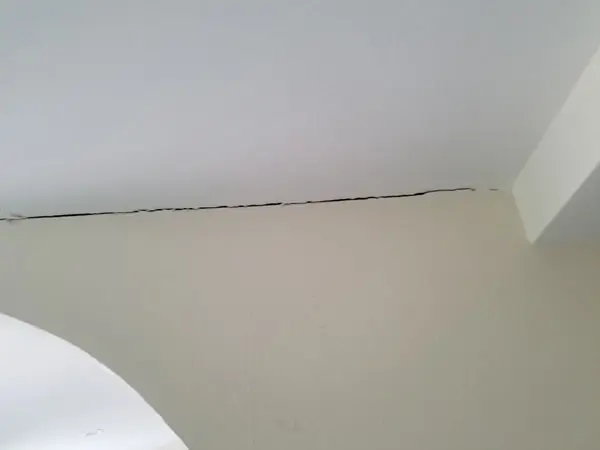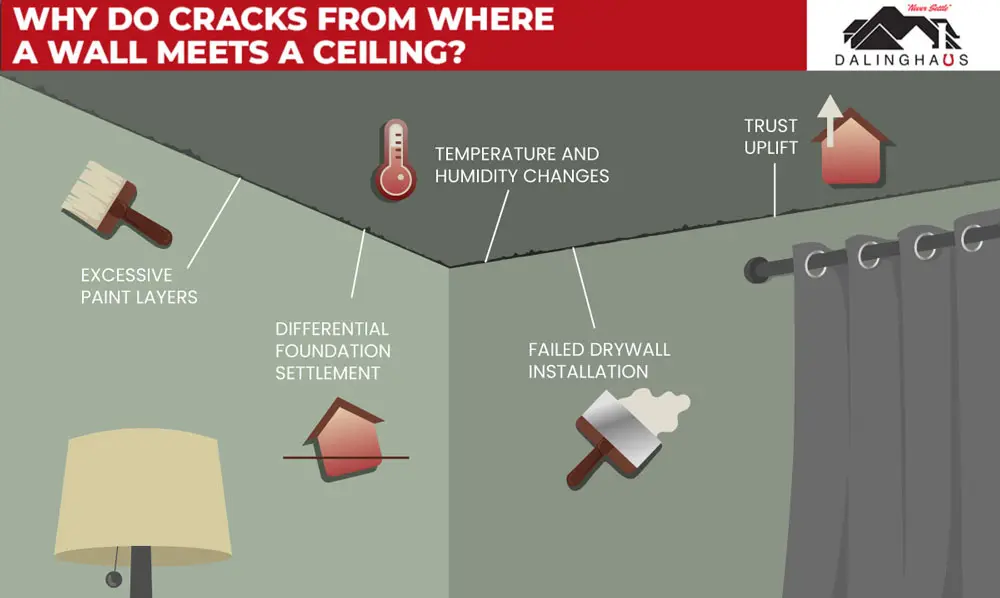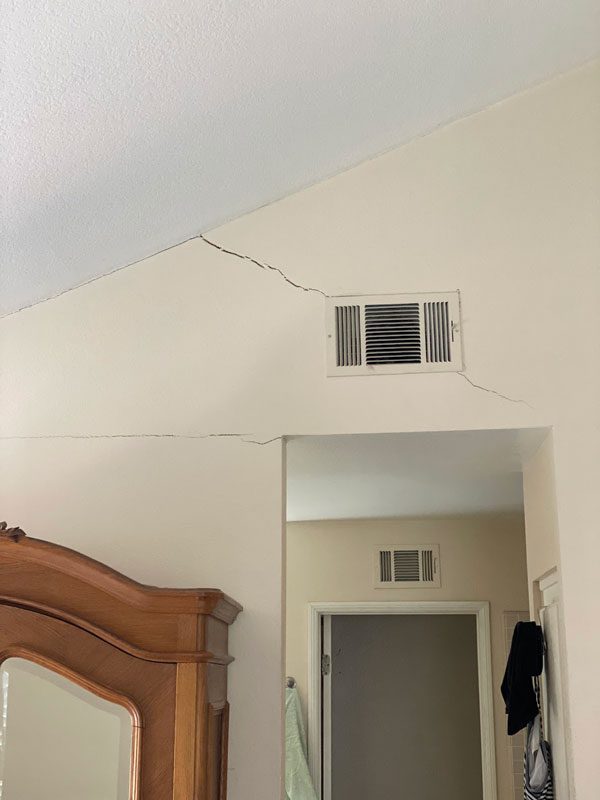Have you ever noticed cracks where your walls meet your ceilings? If so, you probably wondered how they got there and whether or not they are something you should worry about.
Interestingly, there are several reasons why cracks may appear at this upper portion of an interior wall. In the article below, we’ll explain a few of those wall crack causes before sharing the best approach for repairing them.
Why Do Cracks Form Where a Wall Meets a Ceiling?
There are multiple reasons why a crack may appear where your wall and ceiling meet. Each of those causes can call for a different repair approach. However, the first step towards finding the right repair for you is to discover the specific cause of your crack.
Excessive Paint Layers

Our first reason that a crack may form where your ceiling and wall connect is one that should not be a cause for serious concern. Over the years, it is common for people to paint and repaint their walls. As this occurs, each layer of paint gets applied to the previous layer.
When enough paint builds up, it is common for some of the outer layers to become cracked. These cracks are often relatively small and do not indicate any sort of structural damage. At worst, paint-related cracks are nothing more than an eyesore that you can resolve on your own or by hiring a professional paint crew to remedy the issue.
Failed Drywall Installation
Sometimes, the reason that your walls crack close to the ceiling relates to improper drywall installation. While drywall is incredibly common, there are errors that can occur during the installation process, which often cause cracks to form shortly after the project is complete.
If you hire an inexperienced drywall technician who makes a mistake or chooses to cut corners, you can expect cracks and other issues with your drywall to arise in the near future. The good news is that these cracks also don’t indicate structural damage, and hiring a skilled drywall team can quickly remedy the problem.
Temperature and Humidity Changes
Our third cause of wall cracks is also drywall-related. However, unlike the previous reason, this one does not arise due to improper installation. Instead, if there are significant changes in temperature or the relative humidity near your wall, both of those fluctuations can cause the drywall to shrink and expand, which often leads to cracking.

A drywall crack is just one of the many issues that excessive moisture can cause. As such, you’ll want to address any moisture concerns as soon as possible. Often, running a dehumidifier can be a quick way to relieve problems related to high humidity.
Structural Inefficiencies
While the causes of wall cracks we have discussed so far have been relatively benign, these cracks can also arise due to underlying structural problems. For example, if the joists that support your ceiling have too much space between them, they can fail to support the ceiling fully. This typically causes sagging, which then causes cracks to form at the corners.
Similarly, if you have made any changes to the interior of your home, such as removing a weight-bearing wall, this can also cause your ceiling to sag and crack. In either case, you’ll likely need to hire a contractor to repair or replace the structural elements that have begun to fail.
Differential Foundation Settlement
The foundation of your home depends on the soil below it for support. However, when that soil shifts, or sinks, the foundation and the rest of your home will sink and shift as well. This phenomenon is known as foundation settling.
A small amount of even settling is normal following the initial construction of a home. By contrast, the type of settling known as differential settling is more severe, uneven, and can cause a wide range of issues. Cracks in your walls are just one of the signs that differential settling has occurred.
Truss Uplift
Truss uplift is an issue that can affect the ceiling that separates the top floor of your home and your attic. During the winter months, the air above this ceiling can have a significantly different temperature and level of moisture compared to the air below it. This dramatic difference in heat and humidity can cause the truss to warp upwards.
As the truss warps, the entire ceiling will curve as well. When the curve becomes dramatic enough, cracks will begin to form on the ceiling and where the ceiling meets the walls below it. As you might guess, truss uplift is not something you can repair on your own. Instead, you’ll need to seek the help of a professional contractor.
Repairing Cracks Between the Wall and Ceiling
Based on the sections above, it is clear that the proper repair for your wall cracks depends on the cause. The two sections below will give a brief explanation of the steps you should take to repair your wall cracks based on the reason they have appeared.
Paint and Drywall Cracks
If your wall cracks due to paint or drywall issues, you’ll be pleased to know that finding a way to repair them will be relatively quick and easy. If layers of paint have built up and begun to crack, scraping them off and repainting the wall is often the best approach.
Similarly, if you have drywall issues, hiring a skilled drywall contractor is the best way to eliminate cracks. While it may be tempting to perform DIY drywall repairs, hiring a professional is the best way to make sure you get the job done right.
Structural Wall Cracks

Cracks that form due to structural issues are more concerning and require a more in-depth approach to repairs. In most cases, you’ll need to bring in a professional to identify the structural problem causing the cracks before implementing a solution.
For example, if you are dealing with a sagging ceiling or truss uplift, you’ll need a contractor to alter the joists and other supporting structures within your ceiling. If your cracks occur due to differential settling, the repair process will become even more complicated.
With that said, differential settling can cause many problems for your home, which is why you should address it as soon as possible. A skilled foundation repair team will find the best solution for your home, which may include excavation and the installation of piers to level and add stability to your foundation.
Get Help From the Experts
If you are unsure of what is causing your wall cracks, the best decision you can make is to schedule an evaluation with a knowledgeable contractor. Those professionals will be most capable of diagnosing the problem and finding the right fix.
If you live in Southern California, Nevada, or Arizona, Dalinghaus Construction should be your go-to choice for any structural issues related to your foundation. Thanks to our extensive experience, we’re confident that we can support you with any questions or concerns you may have. Reach out today to schedule a free evaluation.






